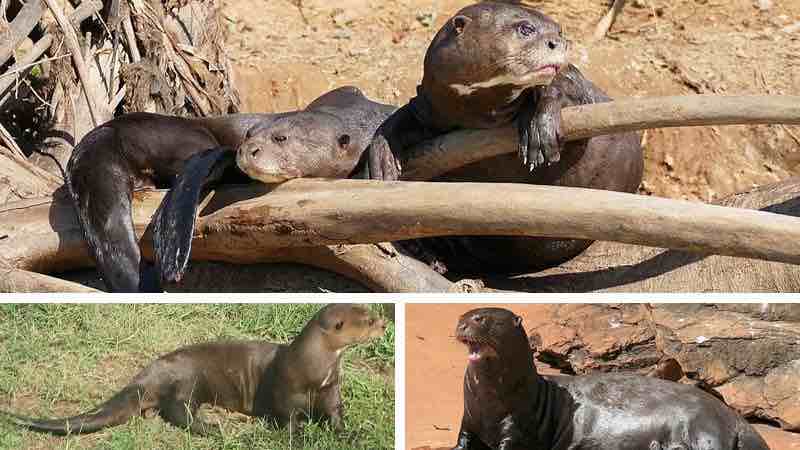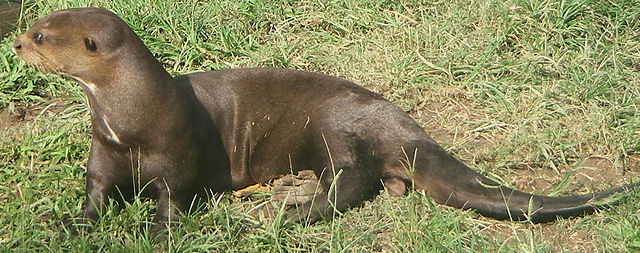
Characteristics, reproduction and behavior, what does the giant otter eat? Is it in danger of extinction? Ethnozoology.
The giant otter, also called the river otter, river wolf, water dog, choker wolf, arnay ariray, ariranha, or tie wolf (Pteronura brasiliensis) is a carnivorous mammal, mostly piscivorous, of the mustelid family (which groups the otters).
It is considered the longest species among the mustelids of the riparian and lacustrine environments of the neotropical zones.
It is large, the male reaching a length of 1.80 meters. The giant otter is the longest of the 13 otter species in the world, although not the heaviest (Utreras, Jorgenson 2003).
It is considered that its ancestor was probably the satherium, which arrived in Americas during the Pliocene or early Pleistocene.
The giant otter inhabits almost exclusively the Amazon-Orinoquia river basin, although it has been extremely persecuted and hunted, to the point that its habitat has been significantly reduced.
Giant otter characteristics
It is a species, the only one in the genus Pteroneura, which has short, very dense hair, 8 mm thick, velvety in appearance, ranging in color from light brown to a darker shade.
It has a sort of knot on its neck (which is why it is also called choker wolf or tie wolf), ranging in color from cream to white, a unique spot for each individual, allowing identification.
Its muzzle is short, its ears are small and rounded. The nose is covered with hairs.

Author: Renaud d’Avout d’Auerstaedt CCBY
It has vibrissae, like a moustache, which are used to detect changes in water pressure, and very useful for locating prey.
Its limbs are short and thick. It has sharp claws, webbed feet, with interdigital membranes on the legs.
The tail is thick, wide and strong, in the shape of a wing, a characteristic that gives its name to its genus, derived from two Greek words: pteron, wing and ura, tail.
The tail, which can reach up to 69 cm in length, allows it to swim and move quickly in the water.
It has excellent eyesight, which favors it in the capture of its prey, complemented by very acute hearing and a magnificent sense of smell.
It frequently emits vocalizations, very noisy, as signals of alarm, aggression, uneasiness, and even calm, depending on the situation or context.
Giant otter reproduction and behavior
There are not many studies on the biology and behavior of the giant otter. However, reviewing the existing information, it can be pointed out that it is a social animal, gregarious, very rarely solitary, that travels in groups of two to eight or more individuals, and even up to 12 individuals of different ages, very united, with a sense of cooperation in the group.
They are territorial, managed by a dominant couple, which brings together their sometimes large family.
Sometimes they come into conflict with individuals of the same species, which is common among predatory animals; this is known as intraspecific aggression, an unusual trait among mustelids. Their habits are diurnal.
The species presents sexual dimorphism. The male is larger (1.50 to 1.80 m long and weighing 22 to 45 kg) than the female (1.50 to 1.70 m long and weighing 22 to 26 kg).
In each group there is a dominant pair. Copulation takes place in the water.
The gestation period varies between 65 and 70 days, following which the female gives birth to between one and five young, with an average of two young per birth.
The female gives birth in burrows, open cavities in the banks of rivers, in hidden places with little traffic. The mother jealously watches over the development of her young.
Hatchlings are born blind and hairless. Around the first month of life they open their eyes, and by 12-14 weeks of age they are swimming with some dexterity.
The individual reaches sexual maturity at two years of age, when it separates from the group to form its own family.
Its life span in the wild is about eight years, while in captivity it reaches 17 to 19 years.
What does the giant otter eat?
The giant otter is a predatory, carnivorous animal and feeds on many types of animals.
It is mainly piscivorous, closely related to the availability of food in its habitat.
It prefers black water rivers that flow in lowlands in the Amazon region.

Their diet consists mainly of catfish (of the family Pimelodidae), piranhas (family Serrasalmidae), and bocachicos or boquichicos, (family Curimatidae); although it behaves as an “opportunistic” consumer, according to the availability of food in the habitat, feeding also on crabs, snakes, small animals and offspring of anacondas.
Each day the giant otter consumes about 10% of its body weight.
They usually feed at certain sites, which specialists call “feeding tables,” easily recognizable by the concentration of bones and scale remains on the river banks, and also by their strong odor of urine and excrement.
Is the giant otter endangered?
The giant otter does not have many predators, although the two most frequent predators are humans and the crocodile or black caiman (Melanosuchus niger).
The human being has been a relentless exterminator of the species. During the 1960s and 1970s, the giant otter was hunted and its pelts were targeted for export to Europe and the United States, as well as fat for local consumption.
This situation was repeated in all regions of the Amazon basin, except perhaps to a lesser degree in Guyana. In some regions it was much greater, as occurred in the northern Ecuadorian Amazon between 1942 and 1965, when almost 90% of the entire population of giant otters was killed.
Some estimate that in a period of a little more than forty years, between 1942 and 1985, between 30,000 and 40,000 skins were exported from Ecuador to Germany, France, Italy and the United States (Utreras, Jorgenson 2003).
The same thing happened in the Colombian Amazon during the infamous “tigrilleo” period, between 1940 and 1970, when the population of big cats, such as jaguars and ocelots, and also giant otters were intensively hunted.
Because of its population decline, the giant otter was included in the IUCN red list as an endangered species in 1999.
Some other factors affect the conservation of the species, such as its relatively late sexual maturity, and the constant degradation of its habitat, to which the species is very sensitive.
Also playing a role were the continuous and increasing deforestation in the headwaters and riverbanks, the growing mercury contamination of water as a result of mining operations, and the advance of agriculture in the basin, which implied the use of pesticides.
Fortunately, the situation is changing, and the population is slowly recovering, following the establishment of community management plans in the Ecuadorian Amazon since 2004.
Ethnozoology
The formative elements of the ancient worldviews of the native Amazonian indigenous communities have exerted a certain influence to preserve certain species.

Author: Eric Gaba (Sting – fr:Sting) / CC BY-SA
One of them was the giant otter. In the Ecuadorian Amazon, where the Kichwa, Shuar and Achuar indigenous peoples live, the giant otter was considered a sacred animal.
It represented the metamorphosis of the water spirits called tshunki, or a yachak owner of the rivers.
The giant otter was recognized as yacu puma, a spirit or tutelary goddess protector of the lagoons (Jácome-Negrete 2016).
As this worldview, or at least the beliefs and traditions related to the giant otter, changed due to the influence of urban religion and economic activities, the positive view of the otter changed and became somewhat negative, creating conflict situations between the wildlife and the natives and settlers, with the fishermen believing that the water dog, as they call it in the area of the Estrella Fluvial de Inírida, in Guainía, Colombia, eats or scares away the fish, thus reducing fishing.
Mariaca-Villavicencio (2018) studies the coexistence between fishers and river otters, based on trophic interactions and human perceptions in the region.
BIBLIOGRAPHY
- Carter S.K. , Rosas F.C.W. (1997). Biology and Conservation of the Giant Otter(Pteronura brasiliensis). Mammal Review 27 (1)1-26.
- Duplaix N. (1980). Observation on the ecology and behavior of the giant river otter Pteronura brasiliensis in Suriname. Revue d’Ecologie (terre Vive). 34. 495-620.
- Evangelista E., Rojas F. (2011). Breeding behavior of giant otter (Pteronura brasiliensis) in the Xixuaí Reserve, Roraima, Brazil. IUCN Spec. Group Bull. 28 (A), 5-10.
- Jácome-Negrete I. (2016). A Kichwa ethnozoological study of the giant otter Pteronura brasiliensis (Zimmerman, 1780) in the lower central Amazon of Ecuador. Neotropical Biodiversity, Vol. 2 (1), 1-11.
- Laidler P.E. (1984). The behavioural ecology of of the giant otter. Doctoral Dissertation. University of Cambridge.
- Mariaca-Villavicencio A.L. (2018). Trophic ecology aspects of the giant otter (Pteronura brasiliensis) and its interaction with fishing activities in the Estrella Fluvial de Inírida, Guainía, Colombia. Master’s thesis. Faculty of Environmental and Rural Studies. Pontifica Universidad Javeriana, Bogotá.
- Utreras V., Tirira D. (2011). Giant otter (Pteronura brasiliensis), 61-63, in D. Tirira (ed.). Red book of the mammals of Ecuador. Quito: SIMBIDE/ Ecociencia/ Ministerio del Ambiente / UICN. Volume I, 96-97.
- Utreras V., Suárez E., Zapata-Ríos G. et al (2005). Dry and rainy season estimations of Giant otter(Pteronura brasiliensis) home-range in the Yasuni National Park, Ecuador. The Latin American Journal of Aquatic Mammals, 4 (2), 191-194.
- Utreras V., Jorgenson J.P. (2003). Aspects of hunting and the current and historical distribution of the giant otter(Pteronura brasiliensis). 130-135. Conservation. On-site management.
- Wozencraft W., Chritopher R. (2005). Pteronura brasiliensis , in: D. Wilson, D. Reeder (eds). Mammals species of the World. Baltimore: John Hopkins University Press. 2 vols. 3rd ed.

Dr. Rafael Cartay is a Venezuelan economist, historian, and writer best known for his extensive work in gastronomy, and has received the National Nutrition Award, Gourmand World Cookbook Award, Best Kitchen Dictionary, and The Great Gold Fork. He began his research on the Amazon in 2014 and lived in Iquitos during 2015, where he wrote The Peruvian Amazon Table (2016), the Dictionary of Food and Cuisine of the Amazon Basin (2020), and the online portal delAmazonas.com, of which he is co-founder and main writer. Books by Rafael Cartay can be found on Amazon.com
This post is also available in:
![]() Español (Spanish)
Español (Spanish)
